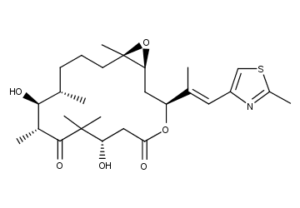Epothilone B CAS NO 152044-54-7 Inquire about Epothilone B
Tecoland supplies Epothilone B bulk active pharmaceutical ingredient (API) to the pharmaceutical industry. Our Epothilone B is manufactured by cGMP compliant facility. Welcome to contact us for further details including current DMF status for the product and up to date regulatory status of the manufacturing facility. We look forward to assisting you with your research and development projects.
Epothilone Description
The epothilones are a new class of cytotoxic molecules identified as potential chemotherapeutic drugs. As of September 2008, epothilones A to F have been identified and characterised. Early studies in cancer cell lines and in human cancer patients indicate superior efficacy to the taxanes. Their mechanism of action is similar, but their chemical structure is simpler. Due to their better water solubility, cremophors (solubilizing agents used for paclitaxel which can affect cardiac function and cause severe hypersensitivity) are not needed.Endotoxin-like properties known from paclitaxel, like activation of macrophages synthesizing inflammatory cytokines and nitric oxide, are not observed for epothilone B.
Epothilone Mechanism of action
The principal mechanism of the epothilone class is inhibition of microtubule function. Microtubules are essential to cell division, and epothilones therefore stop cells from properly dividing. Epothilone B possess the same biological effects as taxol both in vitro and in cultured cells. This is because they share the same binding site, as well as binding affinity to the microtubule. Like taxol, epothilone B binds to the αβ-tubulin heterodimer subunit. Once bound, the rate of αβ-tubulin dissociation decreases, thus stabilizing the microtubules. Furthermore, epothilone B has also been shown to induce tubulin polymerization into microtubules without the presence of GTP. This is caused by formation of microtubule bundles throughout the cytoplasm. Finally, epothilone B also causes cell cycle arrest at the G2-M transition phase, thus leading to cytotoxicity and eventually cell apoptosis.
Epothilone Clinical trials
Several epothilone analogs are currently undergoing clinical development for treatment of various cancers. One analog, ixabepilone, was approved in October 2007 by the United States Food and Drug Administration for use in the treatment of aggressive metastatic or locally advanced breast cancer no longer responding to currently available chemotherapies. In November 2008, the EMEA has refused a marketing authorisation for Ixabepilone.
Epothilone B has proven to contain potent in vivo anticancer activities at tolerate dose levels in several human xenograft models.As a result, epothilone B and its various analogues are currently undergoing various clinical phases (patupilone [EPO906] and sagopilone [SH-Y03757A, ZK-EPO, chemical structure] are in phase II trials; BMS-310705 and BMS-247550 in phase I trials). Results of a phase III trial with ixabepilone in combination with capecitabine in metastatic breast cancer have been announced.
Epothilone Organic synthesis
Due to the high potency and clinical need for cancer treatments, epothilones have been the target of many total syntheses.The first group to publish the total synthesis of epothilones was S. J. Danishefsky et al. in 1996.This total synthesis of epothilone A was achieved via an intramolecular ester enolate-aldehyde condensation. Other syntheses of epothilones have been published by Nicolaou, Schinzer, Mulzer, and Carreira. In this approach, key building blocks aldehyde, glycidols, and ketoacid were constructed and coupled to olefin metathesis precursor via an aldol reaction and then an esterification coupling. Grubbs’ catalyst was employed to close the bis terminal olefin of the precursor compound. The resulting compounds were cis- and tran-macrocyclic isomers with distinct stereocenters. Epoxidation of cis- and trans-olefins yield epothilone A and its analogues.
Epothilone Biosynthesis
Epothilone B is a 16-membered polyketide macrolactone with a methylthiazole group connected to the macrocycle by an olefinic bond. The polyketide backbone was synthesized by type I polyketide synthase (PKS) and the thiazole ring was derived from a cysteine incorporated by a nonribosomal peptide synthetase (NRPS). In this biosythesis, both PKS and NRPS use carrier proteins, which have been post-translationally modified by phosphopantheteine groups, to join the growing chain. PKS uses coenzyme-A thioester to catalyze the reaction and modify the substrates by selectively reducing the ? carbonyl to the hydroxyl (Ketoreductase, KR), the alkene (Dehydratase, DH), and the alkane (Enoyl Reductase, ER). PKS-I can also methylate the ? carbon of the substrate. NRPS, on the other hand, uses amino acids activated on the enzyme as aminoacyl adenylates. Unlike PKS, epimerization, N-methylation, and heterocycle formation occurs in NRPS enzyme.
Disclaimer:
Information on this page is provided for general information purposes. You should not make a clinical treatment decision based on information contained in this page without consulting other references including the package insert of the drug, textbooks and where relevant, expert opinion. We cannot be held responsible for any errors you make in administering drugs mentioned on this page, nor for use of any erroneous information contained on this page.